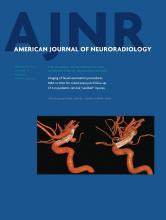Research ArticleNeurointervention
Effect of Structural Remodeling (Retraction and Recoil) of the Pipeline Embolization Device on Aneurysm Occlusion Rate
L.-D. Jou, B.D. Mitchell, H.M. Shaltoni and M.E. Mawad
American Journal of Neuroradiology September 2014, 35 (9) 1772-1778; DOI: https://doi.org/10.3174/ajnr.A3920
L.-D. Jou
aFrom the Departments of Radiology (L.-D.J., H.M.S., M.E.M.)
B.D. Mitchell
bNeurosurgery (B.D.M.), Baylor College of Medicine, Houston, Texas.
H.M. Shaltoni
aFrom the Departments of Radiology (L.-D.J., H.M.S., M.E.M.)
M.E. Mawad
aFrom the Departments of Radiology (L.-D.J., H.M.S., M.E.M.)

Submit a Response to This Article
Jump to comment:
No eLetters have been published for this article.
In this issue
American Journal of Neuroradiology
Vol. 35, Issue 9
1 Sep 2014
Advertisement
L.-D. Jou, B.D. Mitchell, H.M. Shaltoni, M.E. Mawad
Effect of Structural Remodeling (Retraction and Recoil) of the Pipeline Embolization Device on Aneurysm Occlusion Rate
American Journal of Neuroradiology Sep 2014, 35 (9) 1772-1778; DOI: 10.3174/ajnr.A3920
Jump to section
Related Articles
Cited By...
- Braid stability after flow diverter treatment of intracranial aneurysms: a systematic review and meta-analysis
- Braids and beyond: a comprehensive study on pipeline device braid stability from PREMIER data
- Wall Apposition Is a Key Factor for Aneurysm Occlusion after Flow Diversion: A Histologic Evaluation in 41 Rabbits
This article has not yet been cited by articles in journals that are participating in Crossref Cited-by Linking.
More in this TOC Section
Similar Articles
Advertisement











